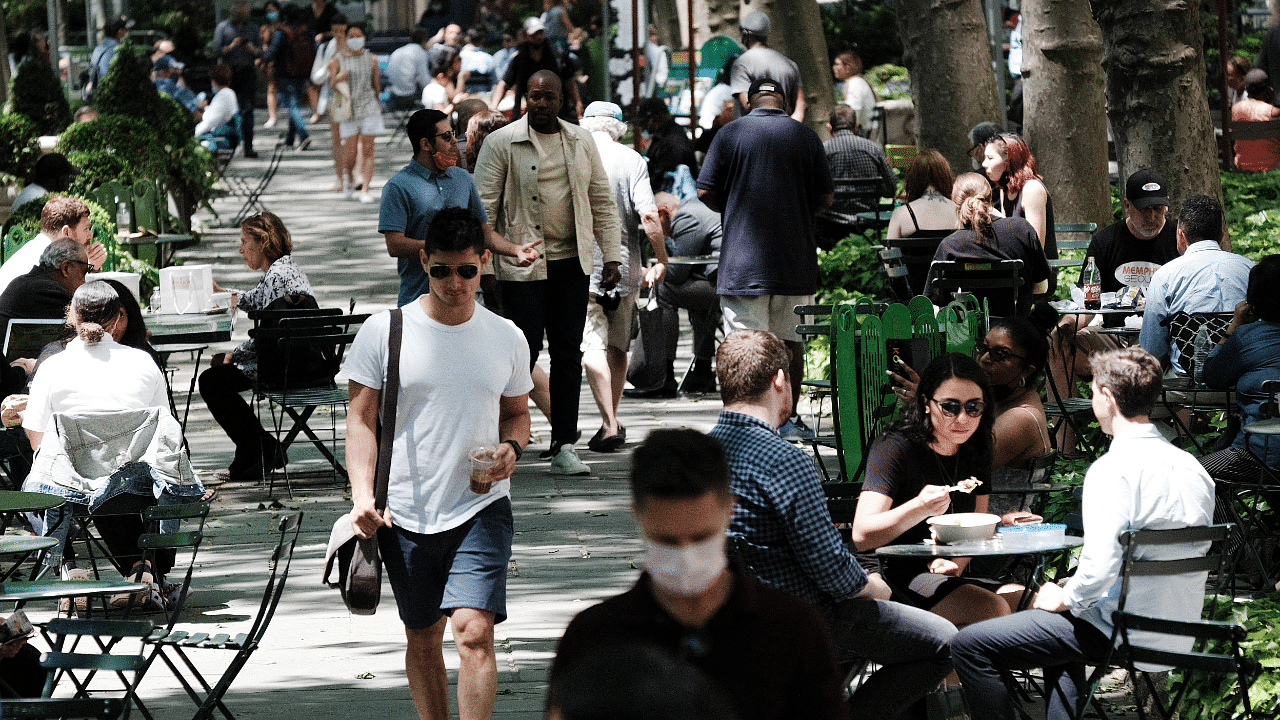
By James Paton and Robert Langreth
Just a few weeks ago, much of the world seemed poised to leave Covid behind.
US President Joe Biden declared the US close to independence from the virus. Britons hit the dance floor to celebrate “Freedom Day.” Singapore’s legendarily strict government signaled it would begin to loosen its zero-cases approach and make life and travel more manageable.
But if those places were ready to be done with Covid, Covid wasn’t done with them.
The sputtering US vaccine campaign has run headlong into the highly-contagious delta variant. The UK’s reopening has coincided with a new surge in cases and fears of “long Covid” in younger people. In Africa, deaths have spiked as vaccine supplies remain meager. And in Japan, rising infections have forced the already-delayed Summer Olympics to be played in empty stadiums and arenas.
Around the globe, people and governments are finding out that Covid won’t be thrashed into extinction, but is more likely to enter a long, endemic tail. With that will come delayed recoveries in the places that have had the least access to vaccines. And vaccine- and resource-rich countries will still face their own health and economic aftershocks, as the US and UK are discovering.
“The virus is going to do what it wants to do,” said Michael Osterholm, director of the Center for Infectious Disease Research and Policy at the University of Minnesota, “and not what we want to do.”
Vaccines have made a difference — in the places that have deployed them widely. In recent weeks, UK cases had risen dramatically, but there hasn’t been an equivalent surge in deaths, and the number of new infections has dropped over the last few days. The shots are literal life savers.
At its current pace of vaccination, 75 per cent of the EU population will be inoculated within two months, a level that may be sufficient to push back the virus. China and the UK are running at a similar pace, according to the Bloomberg Vaccine Tracker.
But after racing ahead, the now-stalled US vaccine campaign will take eight or nine months to reach 75 per cent coverage because of entrenched pockets of vaccine resistance in parts of the country. Other places are in more dire straits: Indonesia, with a raging outbreak, is a year and a half away. India will need another year, at its current rate. In Africa, countries like Egypt, Nigeria and South Africa are at least a year away — or far longer, according to Bloomberg’s analysis.
Many lower-income countries are reliant on Covax, the program set up last year to equitably distribute vaccines to every corner of the planet. But the initiative has delivered just 140 million doses of the 1.8 billion it aims to ship by early 2022, hurt by delays in supplies from India.
“The world is divided between countries which do have vaccines and countries which don’t have vaccines,” said Klaus Stöhr, a former World Health Organization official who played a key role in the response to SARS in 2003. In the have-not regions, “the virus is going to end the pandemic, not the vaccine, unfortunately.”
The pandemic struck $15 trillion off global output in the worst peacetime recession since the Great Depression, and the vaccination disparity is creating an economic wedge as richer countries recover more quickly than less-wealthy ones.
“It is creating a two-speed recovery process,” World Bank President David Malpass told reporters on July 15.
On Tuesday, the International Monetary Fund held steady its outlook for global growth at 6 per cent for the year, but within that projection cut its outlook for emerging markets and raised its forecast for advanced economies.
Another, earlier analysis predicted that inequitable allocation of vaccines would be a drag on GDP in advanced economies that have protected most of their citizens, depriving the global economy of trillions of dollars.
The burden is likely to be greatest in the world’s poorest places, Lawrence Summers, the former US Treasury Secretary and a paid contributor to Bloomberg, told reporters on a call earlier this month.
“Covid will be remembered as one of the grave economic events of this century for the US, but potentially the gravest event for parts of the developing world,” said Summers.
There’s a danger this year’s V-shaped rebound mutates into a W shape, where growth lurches lower again before recovering, said Warwick McKibbin, a professor of economics at the Australian National University. Governments are running the biggest deficits since the Second World War and have provided more liquidity in the past year alone than the previous decade combined — limiting their options to prop up economies further, McKibbin said.
The highly contagious delta variant has added to the uncertainty. According to an analysis Monday from Bloomberg Economics the fast-spreading strain could widen the split in how fast more- and less-vaccinated places bounce back.
Warnings of those inequalities have been ringing loudly for some time.
In Africa, only about 1.5 per cent of the population is fully vaccinated, according to the WHO. The continent has been hit by a wave of infections and rising deaths, while health systems are in dire need of oxygen and intensive care beds.
The disparity is stark in the Southeast Asian nation of Indonesia, one of the pandemic’s latest hotspots. There, cases surpassed 50,000 a day, similar to the UK’s recent peak.
But the lower-middle-income country has only given full vaccinations to 6.9 per cent of its population, compared to 56 per cent in the UK That lack of vaccination has contributed to the country’s 1,500-a-day death toll. In the UK, that number is less than 100.